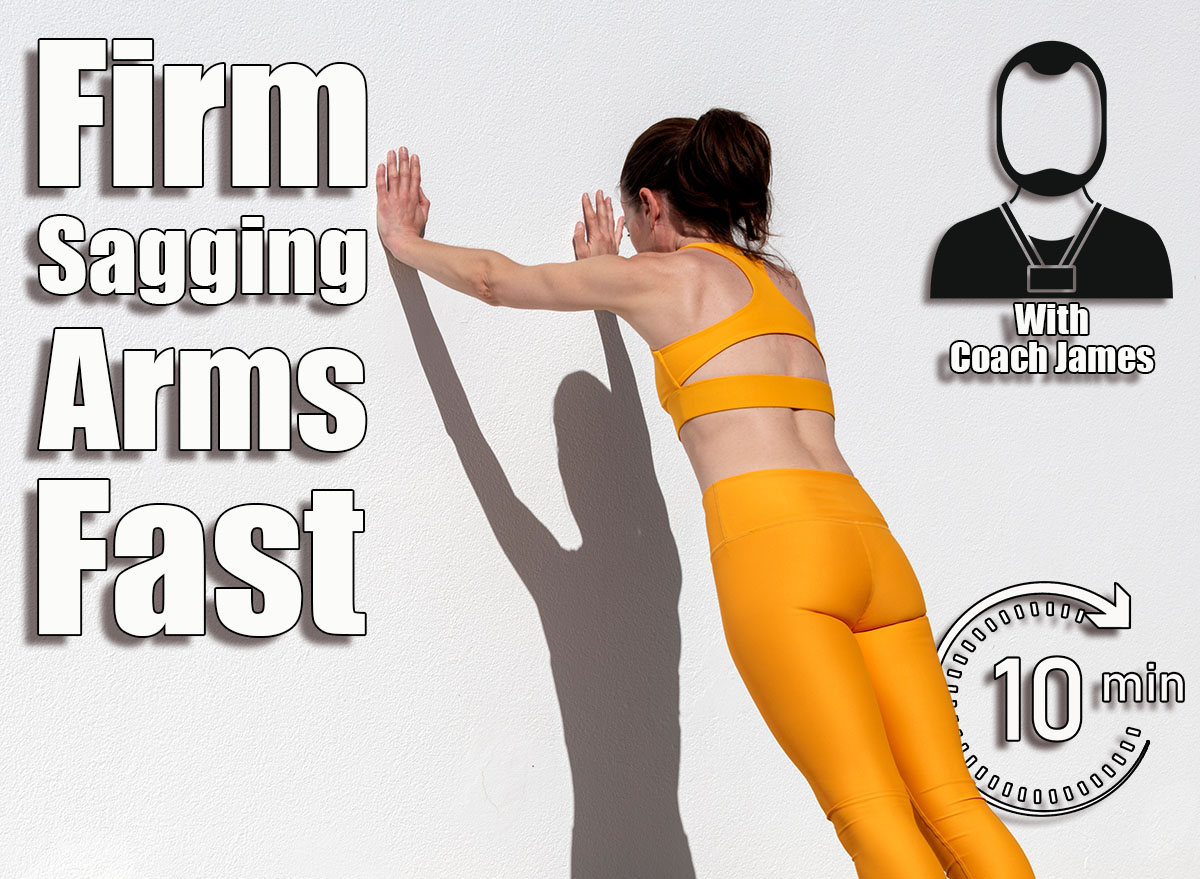5 Quick Exercises That Firm Sagging Arms Better Than Weights After 40

You don’t need a gym membership or heavy dumbbells to tone your arms after 40. While changes in hormones, muscle mass, and collagen can make the skin around your arms lose firmness faster than other areas as you age, studies have found that age-related muscle loss (known as sarcopenia) begins as early as your 30s and accelerates each decade afterward. This can result in weaker triceps, less upper-body definition, and a soft, sagging appearance around the arms.
The good news is you can reverse natural muscle loss with short, targeted, bodyweight and banded movements that are easier on the joints than traditional weights. James Brady, personal trainer at OriGym, tells ETNT, “These exercises are excellent for building strength in the chest, shoulders, and arms without stressing any of your joints.” He adds that these movements are accessible for beginners, scalable for all fitness levels, and “game changing for developing arms, shoulders, and core.”
In this article, we’ve broken down five of Brady’s top exercises to tighten and strengthen your upper arms after 40 safely and efficiently. Read on for the exercises and step-by-step instructions. Then, when you’re finished, don’t miss these 3 Chair Moves That Tighten and Tone Arm ‘Bat Wings’ in 30 Days After 45.
5 Quick Exercises To Firm Sagging Arms
Wall Push-ups
This beginner-friendly variation activates your chest, shoulders, triceps, and core while sparing your wrists and elbows from strain.
How to do it:
- Stand facing a wall, about an arm’s length away.
- Place your hands shoulder-width apart at chest height.
- Bend your elbows to bring your chest toward the wall.
- Push back to the starting position.
- Perform 2 to 3 sets 10 to 15 reps. Rest for one to two minutes between sets.
Common mistakes to avoid: Rushing the movement, arching your lower back, or sagging your hips toward the wall.
Beginner tip: Step closer to the wall to decrease difficulty. Step farther away as you get stronger.
Tricep Chair Dips
Few moves target the back of your arms as effectively as tricep dips. They firm the area most people struggle with (the soft tissue beneath the upper arm) and require nothing more than a sturdy chair.
“These target the exact area you’re looking for, but they’re not too challenging either,” says Brady. “If you want to make it even easier, put your feet flat on the floor instead of being on your heels.”
How to do it:
- Sit on the edge of a sturdy chair, gripping the sides beside your hips.
- Slide your hips forward, keeping your hands planted firmly.
- Bend your elbows to lower your body a few inches.
- Push back up until your arms are straight (but not locked).
- Do 8 to 12 reps for 2 to 3 sets. Rest for one to two minutes between sets.
Common mistakes to avoid: Dropping too low (which strains the shoulders) and flaring your elbows outward.
Beginner tip: Keep your feet flat and knees bent to reduce load and make dips easier.
Modified Plank Shoulder Taps
This full-body movement tones your arms while also engaging your core and shoulders for stability. “These can be quite challenging, but game changing for beginners,” says Brady.
How to do it:
- Start in a kneeling plank position with your hands below your shoulders.
- Engage your core to keep hips steady.
- Tap your right shoulder with your left hand.
- Switch sides and repeat.
- Complete 2 sets of 10 taps per side. Rest for one to two minutes between sets.
Common mistakes to avoid: Rocking side to side or letting your lower back dip.
Beginner tip: Perform the move against a wall or countertop to reduce load while maintaining the same benefit.
Tricep Pushdowns
This move targets the long head of the triceps, the muscle that gives arms a firmer, more sculpted appearance when developed. While this typically requires a cable machine, you can easily replicate it at home using a resistance band looped over a door anchor.
“Tricep pushdowns are essential for targeting the long head of your tricep, making it a lot more solid if you implement them over time with your training,” says Brady.
How to do it:
- Stand facing the band or cable pulley.
- Grip the rope or V-bar attachment with palms facing each other.
- Keep elbows tucked at your sides.
- Push the handles down until your arms are fully extended.
- Squeeze your triceps at the bottom, then slowly return to start.
- Perform 10 to 15 reps for 3 sets. Rest for one to two minutes between sets.
Common mistakes to avoid: Using momentum to push the weight down, flaring your elbows out, or not squeezing at the bottom of the movement.
Beginner tip: Use a lighter band and focus on slow, controlled movement before increasing resistance.
Resistance Band Bicep Curls
Strong, toned biceps complement the triceps for full-arm balance. Resistance bands allow progressive overload—meaning you can build strength without heavy weights.
How to do it:
- Stand in the middle of a resistance band with your feet hip-width apart.
- Hold the handles with your palms facing forward.
- Keep your elbows close to your body.
- Curl your hands toward your shoulders, squeezing at the top.
- Lower slowly to the start position.
- Perform 12 to 15 reps for 2 to 3 sets. Rest for one to two minutes between sets.
Common mistakes to avoid: Swinging your arms or allowing your elbows to drift forward.
Beginner tip: Slow down the tempo and focus on squeezing your biceps for one second at the top.